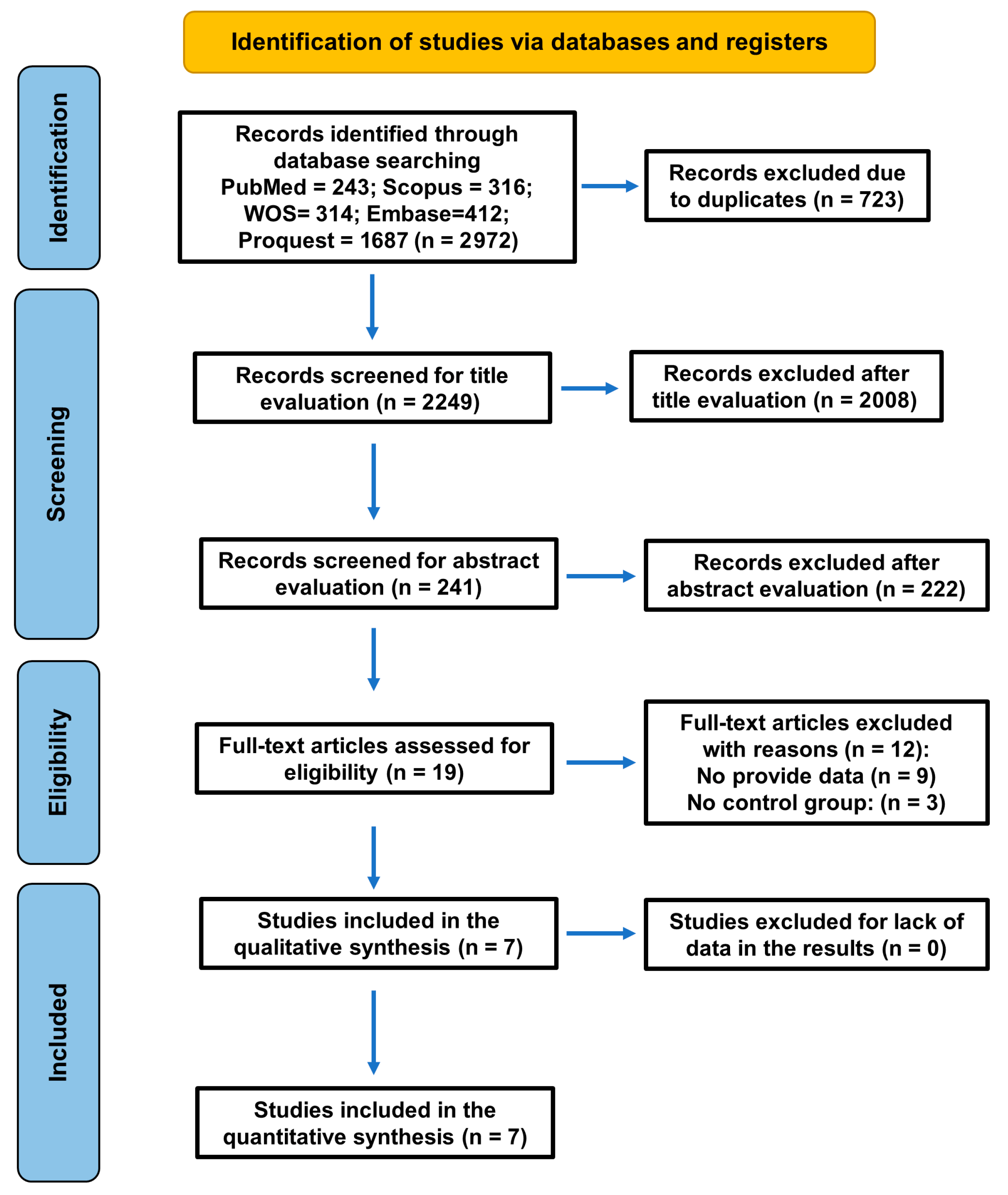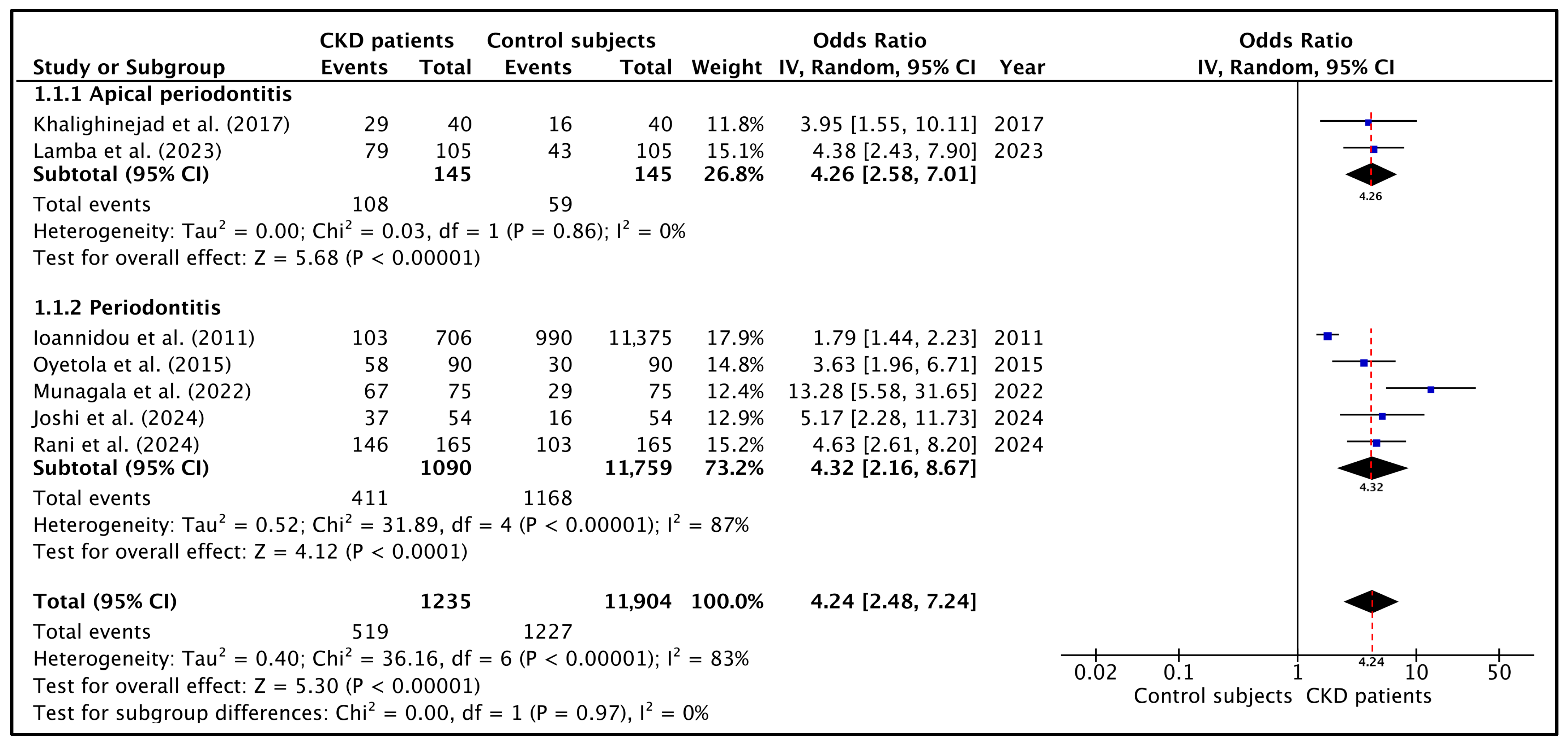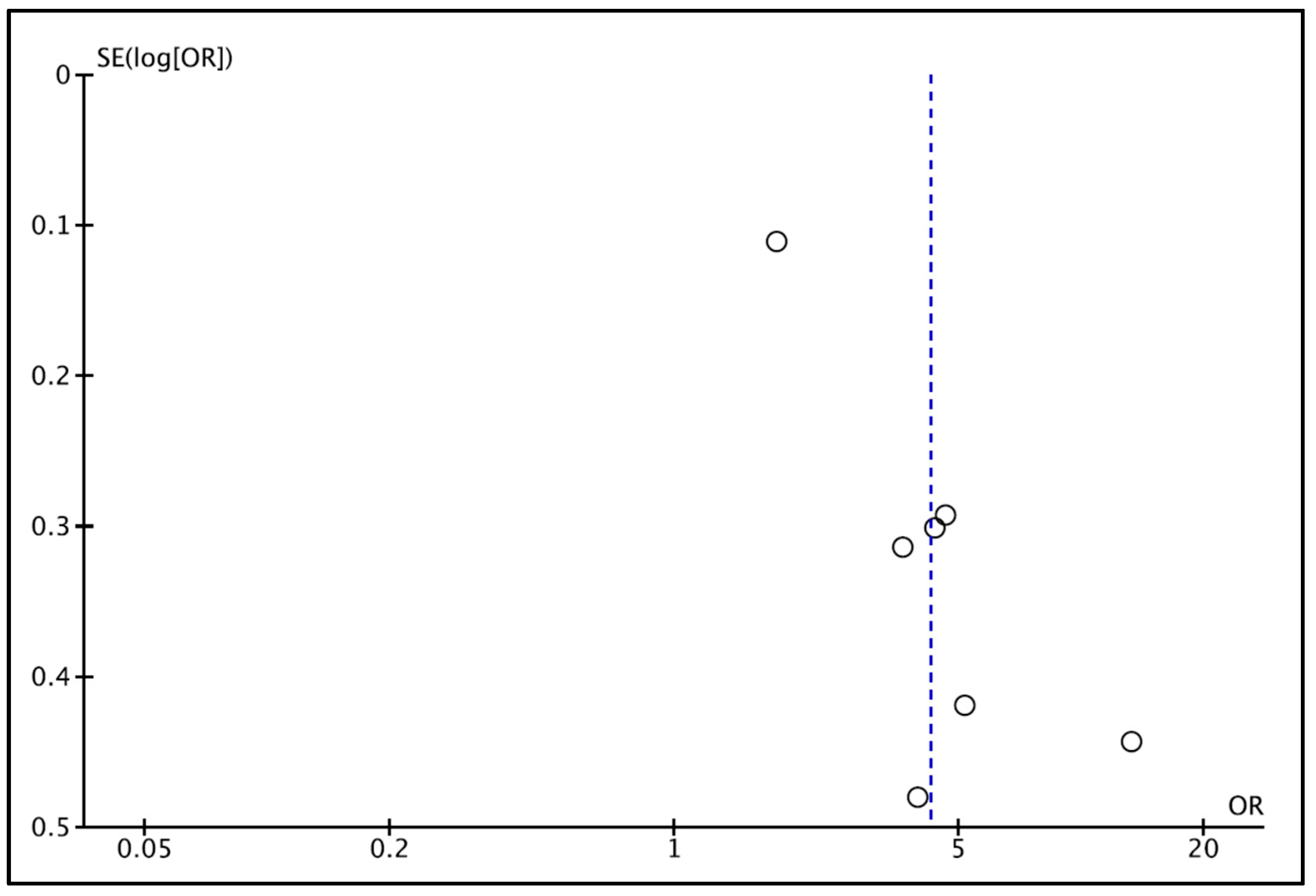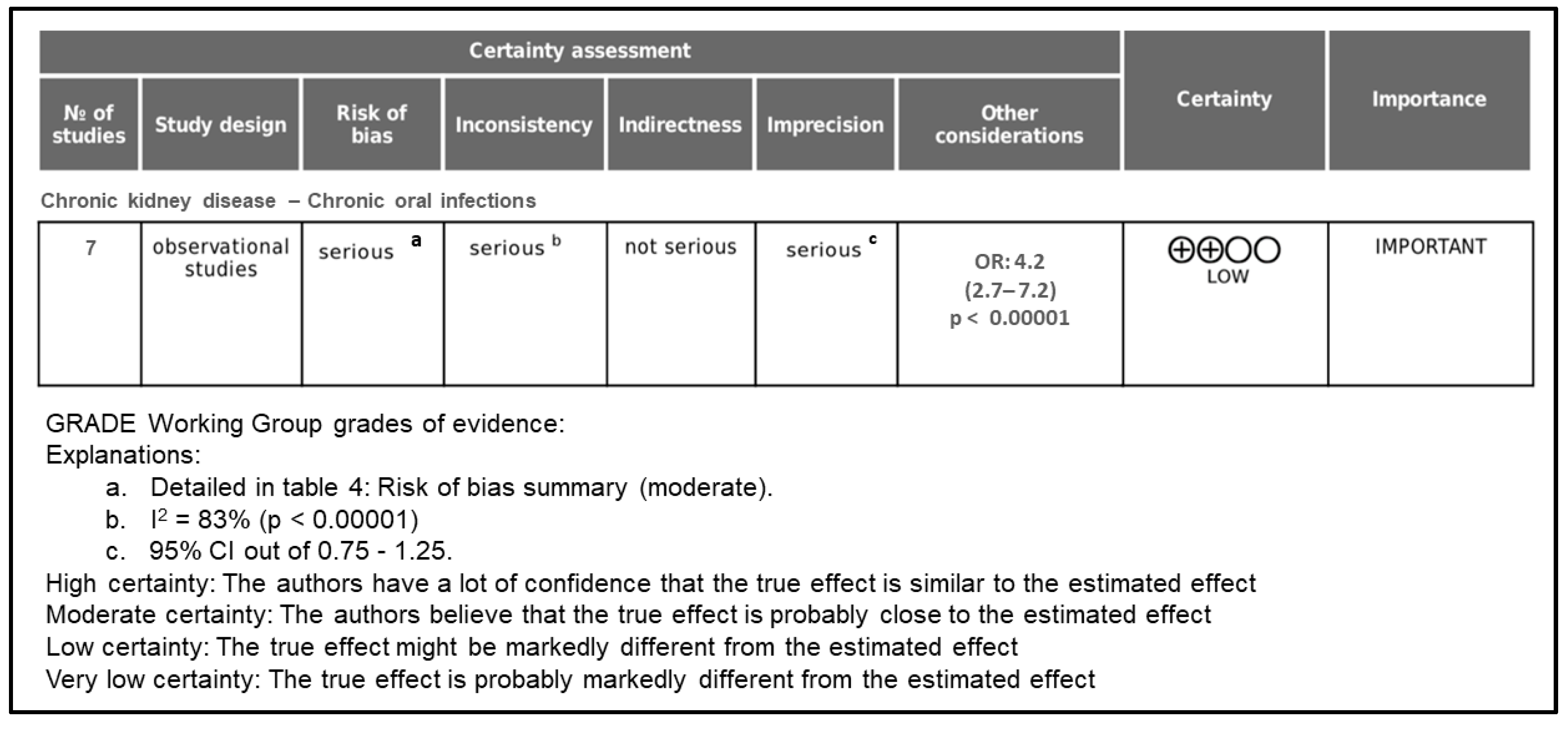Chronic Kidney Disease and Chronic Oral Inflammatory Diseases: A Systematic Review and Meta-Analysis of Periodontitis and Apical Periodontitis
Abstract
1. Introduction
2. Materials and Methods
2.1. Review Question
2.2. Eligibility Criteria
2.3. Search Strategy and Information Sources
2.4. Data Extraction
2.5. Data Synthesis and Analysis
2.6. Risk of Bias Assessment
- -
- Representativeness of the sample: random sampling: two points; non-random sampling or selected group of patients: one point; no explanation of the sampling selection: no points.
- -
- Sample size: the methods for sample size calculation are provided, or the entire population was enlisted (with loss rate ≤ 20%): one point; sample size calculation not provided: no points.
- -
- If the study controlled for or adjusted for the presence of diabetes mellitus (a causal factor in CKD and periodontitis): one point.
- -
- If the study controlled for age, another confounding factor (due to its influence on both conditions): one point; not controlling: no points.
- -
- If the study controlled for another factor, such as sex, smoking habits, socioeconomic level, hypertension, oral hygiene, or duration of dialysis or stage of CKD: one point; not controlling: no points.
- -
- If the diagnosis of AP or PD was based on valid and standardized clinical or radiographic criteria: one point; if the diagnosis was subjective, without defined criteria, or based solely on clinical observation without calibration: no points.
- -
- If the number of observers was two or more: one point; if only one: no points.
- -
- If the examiners were calibrated or inter- and intra-examiner reliability was reported, performing examiner blinding with respect to the group (CKD vs. control): one point; if there was no calibration and inter- and intra-examiner reliability was not reported: no points.
- -
- If the statistical analysis was appropriate to the design (e.g., calculation of OR and 95% CI, use of logistic regression or chi-square as appropriate) and the complete results were reported for all included participants, without data loss or unjustified exclusions: one point; if the analysis was descriptive or incomplete, or the results were not reported by the group: no points.
2.7. Grading of Recommendations Assessment, Development and Evaluation
3. Results
3.1. Characteristics of the Included Studies
| Author, Year | Study Design | Sample | Oral Infection | Diagnostic Criteria for Oral Infections | Main Outcome |
|---|---|---|---|---|---|
| Ioannidou & Swede, (2011) United States [43] | Cross-sectional (NHANES III) | 706 CKD patients 11375 controls | Periodontitis | CDC/AAP criteria | PD significantly more frequent in CKD patients OR = 1.8; 95%IC = 1.5–2.3 p = 0.000 |
| Oyetola et al. (2015) Nigeria [46] | Case-control | 90 CKD patients 90 controls | Periodontitis | Periodontitis was diagnosed when PPD > 3 mm | Periodontitis significantly more frequent in CKD patients p < 0.01 |
| Khalighinejad et al. (2017) Iran [44] | Matched case-control | 40 ESRD patients 40 controls | Apical periodontitis | ≥1 tooth with AP (digital panoramic radiographs and pulp test) | AP significantly more frequent in ESRD patients OR = 3.95; 95% IC = 1.54–6.32 p < 0.05 |
| Munagala et al. (2022) India [45] | Case-control | 75 CKD hemodialysis patients 75 controls | Periodontitis | CDC/AAP criteria | Periodontitis significantly more frequent in CKD patients p < 0.001 |
| Lamba et al. (2023) India [26] | Case-control | 105 CKD patients 105 controls | Apical periodontitis | ≥1 tooth with AP (CBCT) | AP significantly more frequent in CKD patients OR = 3.95; 95%IC = 2.09–7.45 p < 0.001 |
| Joshi et al. (2024) Nepal [47] | Case-control | 54 CKD dialysis patients 54 controls | Periodontitis | CDC/AAP criteria | O R= 5.3; 95%CI = 1.9–14.7 p = 0.000 |
| Rani et al. (2024) India [22] | Matched case-control | 165 ESRD patients 165 controls | Periodontitis | Modified CPI and WHO criteria LOA > 3 mm/PPD > 4 mm | Periodontitis significantly more frequent in ESRD patients p < 0.001 |
3.2. Meta-Analysis of the Prevalence of Oral Infections in CKD Patients
3.3. Sensitivity and Publication Bias
3.4. Risk of Bias Assessment
3.5. GRADE Assessment of Quality of Evidence
- Risk of bias was rated as serious because most included studies presented moderate methodological limitations, such as incomplete control for major confounders (e.g., diabetes, smoking, socioeconomic status) and lack of examiner calibration in the diagnosis of oral diseases.
- Inconsistency was downgraded due to the high level of heterogeneity among studies (I2 = 83.0%), which likely reflects variations in diagnostic criteria, CKD stages, and sample characteristics.
- Imprecision was considered serious because of the limited number of studies (n = 7) and wide confidence intervals in some pooled estimates.
4. Discussion
4.1. Interpretation of the Main Findings
4.2. Methodological Considerations
4.3. Comparison with Other Studies
4.4. Study Limitations
4.5. Clinical Implications
5. Conclusions
Supplementary Materials
Author Contributions
Funding
Institutional Review Board Statement
Informed Consent Statement
Data Availability Statement
Conflicts of Interest
References
- Evans, M.; Lewis, R.D.; Morgan, A.R.; Whyte, M.B.; Hanif, W.; Bain, S.C.; Davies, S.; Dashora, U.; Yousef, Z.; Patel, D.C.; et al. A Narrative Review of Chronic Kidney Disease in Clinical Practice: Current Challenges and Future Perspectives. Adv. Ther. 2022, 39, 33–43. [Google Scholar] [CrossRef]
- González, A.O.; de Francisco, A.; Gayoso, P.; García, F. Prevalence of Chronic Renal Disease in Spain: Results of the EPIRCE Study. Nefrologia 2010, 30, 78–86. [Google Scholar] [CrossRef]
- Kalantar-Zadeh, K.; Jafar, T.H.; Nitsch, D.; Neuen, B.L.; Perkovic, V. Chronic Kidney Disease. Lancet 2021, 398, 786–802. [Google Scholar] [CrossRef]
- Charles, K.; Lewis, M.J.; Montgomery, E.; Reid, M. The 2021 Chronic Kidney Disease Epidemiology Collaboration Race-Free Estimated Glomerular Filtration Rate Equations in Kidney Disease: Leading the Way in Ending Disparities. Health Equity 2024, 8, 39–45. [Google Scholar] [CrossRef] [PubMed]
- Mihai, S.; Codrici, E.; Popescu, I.D.; Enciu, A.M.; Albulescu, L.; Necula, L.G.; Mambet, C.; Anton, G.; Tanase, C. Inflammation-Related Mechanisms in Chronic Kidney Disease Prediction, Progression, and Outcome. J. Immunol. Res. 2018, 2018, 2180373. [Google Scholar] [CrossRef] [PubMed]
- García-Rios, P.; Javier Rodríguez-Lozano, F.; Pérez-Guzmán, N. Systematic Review Oral Findings Linked to Chronic Kidney Disease: A Comprehensive Systematic Review. Compr. Syst. Rev. J. Clin. Med. 2025, 14, 4380. [Google Scholar] [CrossRef]
- Andreoli, D.; Morales Palomares, S.; Mancin, S.; Parozzi, M.; Gazineo, D.; Palmisano, A.; Angileri, S.A.; Ricco, M.; Anastasi, G.; Savini, S.; et al. Exploring the Competencies of Nephrology Nurses: A Comprehensive Scoping Review. Int. Nurs. Rev. 2025, 72, e13085. [Google Scholar] [CrossRef]
- Tibúrcio-Machado, C.S.; Michelon, C.; Zanatta, F.B.; Gomes, M.S.; Marin, J.A.; Bier, C.A. The Global Prevalence of Apical Periodontitis: A Systematic Review and Meta-Analysis. Int. Endod. J. 2021, 54, 712–735. [Google Scholar] [CrossRef] [PubMed]
- Nazir, M.; Al-Ansari, A.; Al-Khalifa, K.; Alhareky, M.; Gaffar, B.; Almas, K. Global Prevalence of Periodontal Disease and Lack of Its Surveillance. Sci. World J. 2020, 2020, 2146160. [Google Scholar] [CrossRef]
- American Association of Endodontists. AAE Consensus Conference Recommended Diagnostic Terminology. J. Endod. 2009, 35, 1634. [Google Scholar] [CrossRef]
- Segura-Egea, J.J.; Martín-González, J.; Castellanos-Cosano, L. Endodontic Medicine: Connections between Apical Periodontitis and Systemic Diseases. Int. Endod. J. 2015, 48, 933–951. [Google Scholar] [CrossRef] [PubMed]
- Ridao-Sacie, C.; Segura-Egea, J.J.; Fernández-Palacín, A.; Bullón-Fernández, P.; Ríos-Santos, J.V. Radiological Assessment of Periapical Status Using the Periapical Index: Comparison of Periapical Radiography and Digital Panoramic Radiography. Int. Endod. J. 2007, 40, 433–440. [Google Scholar] [CrossRef]
- Duncan, H.F.; Kirkevang, L.L.; Peters, O.A.; El-Karim, I.; Krastl, G.; Del Fabbro, M.; Chong, B.S.; Galler, K.M.; Segura-Egea, J.J.; Kebschull, M.; et al. Treatment of Pulpal and Apical Disease: The European Society of Endodontology (ESE) S3-Level Clinical Practice Guideline. Int. Endod. J. 2023, 56, 238–295. [Google Scholar] [CrossRef]
- Tonetti, M.S.; Greenwell, H.; Kornman, K.S. Staging and Grading of Periodontitis: Framework and Proposal of a New Classification and Case Definition. J. Periodontol. 2018, 89, S159–S172. [Google Scholar] [CrossRef]
- Kinane, D.F.; Stathopoulou, P.G.; Papapanou, P.N. Periodontal Diseases. Nat. Rev. Dis. Primers 2017, 3, 17038. [Google Scholar] [CrossRef]
- Hajishengallis, G. Periodontitis: From Microbial Immune Subversion to Systemic Inflammation. Nat. Rev. Immunol. 2015, 15, 30. [Google Scholar] [CrossRef] [PubMed]
- Mattila, K.J.; Pussinen, P.J.; Paju, S. Dental Infections and Cardiovascular Diseases: A Review. J. Periodontol. 2005, 76, 2085–2088. [Google Scholar] [CrossRef]
- Cotti, E.; Mercuro, G. Apical Periodontitis and Cardiovascular Diseases: Previous Findings and Ongoing Research. Int. Endod. J. 2015, 48, 926–932. [Google Scholar] [CrossRef] [PubMed]
- Iacopino, A.M. Periodontitis and Diabetes Interrelationships: Role of Inflammation. Ann. Periodontol. 2001, 6, 125–137. [Google Scholar] [CrossRef]
- Linden, G.J.; Herzberg, M.C. Periodontitis and Systemic Diseases: A Record of Discussions of Working Group 4 of the Joint EFP/AAP Workshop on Periodontitis and Systemic Diseases. J. Clin. Periodontol. 2013, 40, 20–23. [Google Scholar] [CrossRef] [PubMed]
- Herrera, D.; Sanz, M.; Shapira, L.; Brotons, C.; Chapple, I.; Frese, T.; Graziani, F.; Hobbs, F.D.R.; Huck, O.; Hummers, E.; et al. Periodontal Diseases and Cardiovascular Diseases, Diabetes, and Respiratory Diseases: Summary of the Consensus Report by the European Federation of Periodontology and WONCA Europe. Eur. J. Gen. Pract. 2024, 30, 2320120. [Google Scholar] [CrossRef] [PubMed]
- Rani, A.N.; Reddy, M.P.; Kulkarni, S.; Srilatha, A.; Reddy, L.S. Assessment of Periodontal Status in Patients Undergoing Renal Dialysis—A Hospital-Based Study. J. Indian Soc. Periodontol. 2024, 28, 224–230. [Google Scholar] [CrossRef] [PubMed]
- Palmeira, E.; de Liz Pérez-Losada, F.; Díaz-Flores-García, V.; Segura-Sampedro, J.J.; Segura-Egea, J.J.; López-López, J. Prevalence of Oral Infections in Chronic Kidney Disease Patients: A Cross-Sectional Study. Oral Dis. 2024, 30, 2708–2715. [Google Scholar] [CrossRef]
- Dembowska, E.; Jaroń, A.; Rasławska-Socha, J.; Gabrysz-Trybek, E.; Bladowska, J.; Gacek, S.; Trybek, G. The Evaluation of the Periodontal Status of Hemodialysis Patients with End-Stage Renal Disease. J. Clin. Med. 2022, 11, 975. [Google Scholar] [CrossRef]
- Altamimi, A.; AlBakr, S.; Alanazi, T.; Alshahrani, F.; Chalisserry, E.; Anil, S. Prevalence of Periodontitis in Patients Undergoing Hemodialysis: A Case Control Study. Mater. Socio-Medica 2018, 30, 58. [Google Scholar] [CrossRef]
- Lamba, J.; Mittal, S.; Tewari, S.; Jain, D.; Tewari, S.; Duhan, J.; Sangwan, P.; Kumar, V. Association of Apical Periodontitis with Different Stages of Chronic Kidney Disease Measured by Glomerular Filtration Rate and Systemic Markers: An Observational Study. J. Endod. 2023, 49, 1472–1479. [Google Scholar] [CrossRef]
- Page, M.J.; McKenzie, J.E.; Bossuyt, P.M.; Boutron, I.; Hoffmann, T.C.; Mulrow, C.D.; Shamseer, L.; Tetzlaff, J.M.; Akl, E.A.; Brennan, S.E.; et al. The PRISMA 2020 Statement: An Updated Guideline for Reporting Systematic Reviews. Syst. Rev. 2021, 10, 89. [Google Scholar] [CrossRef]
- Cochrane. RevMan Web [COMPUTER Program]; The Cochrane Collaboration: London, UK, 2025; Available online: https://revman.cochrane.org (accessed on 6 November 2025).
- Higgins, J.P.T.; Thompson, S.G. Quantifying Heterogeneity in a Meta-Analysis. Stat. Med. 2002, 21, 1539–1558. [Google Scholar] [CrossRef]
- Herzog, R.; Álvarez-Pasquin, M.J.; Díaz, C.; Del Barrio, J.L.; Estrada, J.M.; Gil, Á. Are Healthcare Workers Intentions to Vaccinate Related to Their Knowledge, Beliefs and Attitudes? A Systematic Review. BMC Public Health 2013, 13, 154. [Google Scholar] [CrossRef] [PubMed]
- León-López, M.; Cabanillas-Balsera, D.; Martín-González, J.; Montero-Miralles, P.; Saúco-Márquez, J.J.; Segura-Egea, J.J. Prevalence of Root Canal Treatment Worldwide: A Systematic Review and Meta-Analysis. Int. Endod. J. 2022, 55, 1105–1127. [Google Scholar] [CrossRef]
- Guyatt, G.H.; Oxman, A.D.; Vist, G.; Kunz, R.; Brozek, J.; Alonso-Coello, P.; Montori, V.; Akl, E.A.; Djulbegovic, B.; Falck-Ytter, Y.; et al. GRADE Guidelines: 4. Rating the Quality of Evidence--Study Limitations (Risk of Bias). J. Clin. Epidemiol. 2011, 64, 407–415. [Google Scholar] [CrossRef]
- Hultcrantz, M.; Rind, D.; Akl, E.A.; Treweek, S.; Mustafa, R.A.; Iorio, A.; Alper, B.S.; Meerpohl, J.J.; Murad, M.H.; Ansari, M.T.; et al. The GRADE Working Group Clarifies the Construct of Certainty of Evidence. J. Clin. Epidemiol. 2017, 87, 4–13. [Google Scholar] [CrossRef]
- Buhlin, K.; Bárány, P.; Heimbürger, O.; Stenvinkel, P.; Gustafsson, A. Oral Health and Pro-Inflammatory Status in End-Stage Renal Disease Patients. Oral Health Prev. Dent. 2007, 5, 235–244. [Google Scholar]
- Katz, J.; Rotstein, I. Prevalence of Periapical Abscesses in Patients with Hypertension: A Cross-Sectional Study of a Large Hospital Population. J. Endod. 2021, 47, 1070–1074. [Google Scholar] [CrossRef] [PubMed]
- Sobrado-Marinho, J.S.; Tomás Carmona, I.; Loureiro, A.; Limeres Posse, J.; Caballero, L.G.; Dios, P.D. Oral Health Status in Patients with Moderate-Severe and Terminal Renal Failure. Med. Oral Patol. Oral Cir. Bucal 2007, 12, E305–E310. [Google Scholar] [PubMed]
- Bayraktar, G.; Kurtulus, I.; Duraduryan, A.; Cintan, S.; Kazancioglu, R.; Yildiz, A.; Bural, C.; Bozfakioglu, S.; Besler, M.; Trablus, S.; et al. Dental and Periodontal Findings in Hemodialysis Patients. Oral Dis. 2007, 13, 393–397. [Google Scholar] [CrossRef]
- Garcez, J.; Limeres Posse, J.; Carmona, I.T.; Feijoo, J.F.; Diz Dios, P. Oral Health Status of Patients with a Mild Decrease in Glomerular Filtration Rate. Oral Surg. Oral Med. Oral Pathol. Oral Radiol. Endodontol. 2009, 107, 224–228. [Google Scholar] [CrossRef] [PubMed]
- Thorman, R.; Neovius, M.; Hylander, B. Clinical Findings in Oral Health during Progression of Chronic Kidney Disease to End-Stage Renal Disease in a Swedish Population. Scand. J. Urol. Nephrol. 2009, 43, 154–159. [Google Scholar] [CrossRef]
- Tadakamadla, J.; Kumar, S.; Mamatha, G.P. Comparative Evaluation of Oral Health Status of Chronic Kidney Disease (CKD) Patients in Various Stages and Healthy Controls. Spec. Care Dent. 2014, 34, 122–126. [Google Scholar] [CrossRef]
- Niedzielska, I.; Chudek, J.; Kowol, I.; Slabiak-Blaz, N.; Kolonko, A.; Kuczera, P.; Wiecek, A. The Odontogenic-Related Microinflammation in Patients with Chronic Kidney Disease. Ren. Fail. 2014, 36, 883–888. [Google Scholar] [CrossRef]
- Ma, L.; Jin, X.; Cao, Y.; Xu, Z.; Xing, S.; Xu, B. Periodontal status of patients undergoing peritoneal dialysis or hemodialysis. Int. J. Clin. Exp. Med. 2016, 9, 16759–16764. [Google Scholar]
- Ioannidou, E.; Swede, H. Disparities in Periodontitis Prevalence among Chronic Kidney Disease Patients. J. Dent. Res. 2011, 90, 730–734. [Google Scholar] [CrossRef]
- Khalighinejad, N.; Aminoshariae, A.; Kulild, J.C.; Sahly, K.; Mickel, A. Association of End-Stage Renal Disease with Radiographically and Clinically Diagnosed Apical Periodontitis: A Hospital-Based Study. J. Endod. 2017, 43, 1438–1441. [Google Scholar] [CrossRef]
- Munagala, K.K.; Nanda, S.; Chowdhary, Z.; Pathivada, L.; Vivekanandan, G.; Bodhi, S. Severity of Periodontal Disease in Chronic Kidney Disease Patients: A Hospital-Based Study. Cureus 2022, 14, e25646. [Google Scholar] [CrossRef]
- Oyetola, E.O.; Owotade, F.J.; Agbelusi, G.A.; Fatusi, O.A.; Sanusi, A.A. Oral Findings in Chronic Kidney Disease: Implications for Management in Developing Countries. BMC Oral Health 2015, 15, 24. [Google Scholar] [CrossRef] [PubMed]
- Joshi, N.P.; Shrestha, A.; Bhagat, T.; Agrawal, S.K.; Chhetri, R. The Oral Health Condition of Patients on Hemodialysis at a Tertiary Healthcare Facility in Eastern Nepal. Int. J. Dent. 2024, 2024, 3776702. [Google Scholar] [CrossRef] [PubMed]
- Baranwal, H.; Mittal, N.; Yadav, J.; Rani, P.; Kumar, N. Outcome of Partial Pulpotomy Verses Full Pulpotomy Using Biodentine in Vital Mature Permanent Molar with Clinical Symptoms Indicative of Irreversible Pulpitis: A Randomized Clinical Trial. J. Conserv. Dent. 2022, 25, 317–323. [Google Scholar] [CrossRef]
- Eke, P.; Page, R.; Wei, L.; Thornton-Evans, G.; Genco, R. Update of the Case Definitions for Population-Based Surveillance of Periodontitis. J. Periodontol. 2012, 83, 1449–1454. [Google Scholar] [CrossRef] [PubMed]
- Gomes, M.S.; Blattner, T.C.; Sant’Ana Filho, M.; Grecca, F.S.; Hugo, F.N.; Fouad, A.F.; Reynolds, M.A. Can Apical Periodontitis Modify Systemic Levels of Inflammatory Markers? A Systematic Review and Meta-Analysis. J. Endod. 2013, 39, 1205–1217. [Google Scholar] [CrossRef]
- Ruospo, M.; Palmer, S.C.; Craig, J.C.; Gentile, G.; Johnson, D.W.; Ford, P.J.; Tonelli, M.; Petruzzi, M.; De Benedittis, M.; Strippoli, G.F.M. Prevalence and Severity of Oral Disease in Adults with Chronic Kidney Disease: A Systematic Review of Observational Studies. Nephrol. Dial. Transplant. 2014, 29, 364–375. [Google Scholar] [CrossRef]
- Grubbs, V.; Vittinghoff, E.; Taylor, G.; Kritz-Silverstein, D.; Powe, N.; Bibbins-Domingo, K.; Ishani, A.; Cummings, S.R. The Association of Periodontal Disease with Kidney Function Decline: A Longitudinal Retrospective Analysis of the MrOS Dental Study. Nephrol. Dial. Transplant. 2016, 31, 466–472. [Google Scholar] [CrossRef]
- Yue, H.; Xu, X.; Liu, Q.; Li, X.; Xiao, Y.; Hu, B. Effects of Non-Surgical Periodontal Therapy on Systemic Inflammation and Metabolic Markers in Patients Undergoing Haemodialysis and/or Peritoneal Dialysis: A Systematic Review and Meta-Analysis. BMC Oral Health 2020, 20, 18. [Google Scholar] [CrossRef]
- Bui, F.Q.; Almeida-da-Silva, C.L.C.; Huynh, B.; Trinh, A.; Liu, J.; Woodward, J.; Asadi, H.; Ojcius, D.M. Association between Periodontal Pathogens and Systemic Disease. Biomed. J. 2019, 42, 27–35. [Google Scholar] [CrossRef]
- Almeida, S.; Figueredo, C.M.; Lemos, C.; Bregman, R.; Fischer, R.G. Periodontal Treatment in Patients with Chronic Kidney Disease: A Pilot Study. J. Periodontal Res. 2017, 52, 262–267. [Google Scholar] [CrossRef] [PubMed]
- Iwasaki, M.; Taylor, G.W.; Nesse, W.; Vissink, A.; Yoshihara, A.; Miyazaki, H. Periodontal Disease and Decreased Kidney Function in Japanese Elderly. Am. J. Kidney Dis. 2012, 59, 202–209. [Google Scholar] [CrossRef] [PubMed]
- Iwasaki, M.; Taylor, G.W.; Sato, M.; Minagawa, K.; Yoshihara, A.; Ansai, T. Effect of Chronic Kidney Disease on Progression of Clinical Attachment Loss in Older Adults: A 4-Year Cohort Study. J. Periodontol. 2019, 90, 826–833. [Google Scholar] [CrossRef]
- Nozu, H.; Tamura, H.; Kudo, T.; Araki, T.; Sato, H.; Watanabe, T.; Sasagawa, I. The Role of Advanced Practice Nurses in Improving Healthcare Outcomes for Patients with Chronic Kidney Disease: A Scoping Review Protocol. PLoS ONE 2024, 19, e0301676. [Google Scholar] [CrossRef] [PubMed]




| Reasons | Excluded Studies |
|---|---|
| Absence of control group | Buhlin et al., 2007 [34] Katz et al., 2021 [35] Palmeira et al., 2024 [23] |
| Lack of necessary data about the prevalence of periodontitis | Thorman et al., 2009 [39] Ma et al., 2016 [42] Altamini et al., 2018 [25] Dembowska et al., 2022 [24] |
| Lack of necessary data about the prevalence of apical periodontitis | Sobrado et al., 2007 [36] Bayraktar et al., 2007 [37] Garcez et al., 2009 [38] Tadakamadla et al., 2013 [40] Niedzielska et al., 2014 [41] |
| Author, Year, Country | Oral Infection | No. Subjects | CKD Patients | Control Subjects | Odds Ratio | ||
|---|---|---|---|---|---|---|---|
| AP or PD/Total | Prevalence CKD (%) | AP or PD/Total | Prevalence Controls (%) | ||||
| Ioannidou & Swede (2011) United States [43] | PD | 12,081 | 103/706 | 14.6 | 990/11,375 | 8.7 | OR = 1.79 95% CI = 1.44–2.23 p = 0.000 |
| Oyetola et al. (2015) Nigeria [46] | PD | 180 | 58/90 | 64.4 | 30/90 | 33.3 | OR = 3.62 95% CI = 1.96–6.71 p = 0.000 |
| Khalighinejad et al. (2017) Iran [44] | AP | 80 | 29/40 | 73 | 16/40 | 40 | OR = 3.95 95% CI = 1.54–6.32 p < 0.05 |
| Munagala et al. (2022) India [45] | PD | 150 | 67/75 | 89.3 | 29/75 | 38.7 | OR = 13.28 95% CI = 5.58–31.64 p = 0.0000 |
| Lamba et al. (2023) India [26] | AP | 210 | 79/105 | 75.2 | 43/105 | 41.0 | OR = 3.95 95% CI = 2.09–7.45 p < 0.001 |
| Joshi et al. (2024) Nepal [47] | PD | 108 | 37/54 | 68.5 | 16/54 | 29.6 | OR = 5.17 95% CI = 2.28–11.73 p = 0.000 |
| Rani et al. (2024) India [22] | PD | 330 | 147/165 | 88.5 | 103/165 | 62.4 | OR = 4.63 95% CI = 2.61–8.20 p = 0.000 |
| OVERALL | 13,139 | 518/1235 | 41.9 | 1227/11,904 | 10.3 | ||
| Author 2011. | Sample Selection | Comparability | Outcome | Risk of Bias | ||||||
|---|---|---|---|---|---|---|---|---|---|---|
| Sample Representativeness | Sample Size | Control for Diabetes | Control for Age | Control for Other Confounding Factors | Diagnostic Criteria | No. Observers | Calibration | Statistical Analysis | ||
| Ioannidou & Swede (2011) [43] | ** | * | * | * | * | * | * | * | * | 10/10 Low |
| Oyetola et al. (2015) [46] | * | * | 2/10 High | |||||||
| Khalighinejad et al. (2017) [44] | * | * | * | * | * | * | 6/10 Moderate | |||
| Munagala et al. (2022) [45] | * | * | * | * | * | 5/10 Moderate | ||||
| Lamba et al. (2023) [26] | * | * | * | * | * | * | * | 7/10 Moderate | ||
| Joshi et al. (2024) [47] | * | * | * | * | 4 High | |||||
| Rani et al. (2024) [22] | * | * | * | * | * | * | * | 7 Moderate | ||
| OVERALL | 8 | 3 | 1 | 5 | 5 | 6 | 4 | 2 | 7 | 41/70 Moderate |
Disclaimer/Publisher’s Note: The statements, opinions and data contained in all publications are solely those of the individual author(s) and contributor(s) and not of MDPI and/or the editor(s). MDPI and/or the editor(s) disclaim responsibility for any injury to people or property resulting from any ideas, methods, instructions or products referred to in the content. |
© 2025 by the authors. Licensee MDPI, Basel, Switzerland. This article is an open access article distributed under the terms and conditions of the Creative Commons Attribution (CC BY) license (https://creativecommons.org/licenses/by/4.0/).
Share and Cite
López-Sanz, L.; León-López, M.; Egido-Moreno, S.; Segura-Raya, C.; López-López, J.; Segura-Sampedro, J.J.; Cabanillas-Balsera, D.; Segura-Egea, J.J. Chronic Kidney Disease and Chronic Oral Inflammatory Diseases: A Systematic Review and Meta-Analysis of Periodontitis and Apical Periodontitis. J. Clin. Med. 2025, 14, 7947. https://doi.org/10.3390/jcm14227947
López-Sanz L, León-López M, Egido-Moreno S, Segura-Raya C, López-López J, Segura-Sampedro JJ, Cabanillas-Balsera D, Segura-Egea JJ. Chronic Kidney Disease and Chronic Oral Inflammatory Diseases: A Systematic Review and Meta-Analysis of Periodontitis and Apical Periodontitis. Journal of Clinical Medicine. 2025; 14(22):7947. https://doi.org/10.3390/jcm14227947
Chicago/Turabian StyleLópez-Sanz, Laura, María León-López, Sonia Egido-Moreno, Carlos Segura-Raya, José López-López, Juan J. Segura-Sampedro, Daniel Cabanillas-Balsera, and Juan J. Segura-Egea. 2025. "Chronic Kidney Disease and Chronic Oral Inflammatory Diseases: A Systematic Review and Meta-Analysis of Periodontitis and Apical Periodontitis" Journal of Clinical Medicine 14, no. 22: 7947. https://doi.org/10.3390/jcm14227947
APA StyleLópez-Sanz, L., León-López, M., Egido-Moreno, S., Segura-Raya, C., López-López, J., Segura-Sampedro, J. J., Cabanillas-Balsera, D., & Segura-Egea, J. J. (2025). Chronic Kidney Disease and Chronic Oral Inflammatory Diseases: A Systematic Review and Meta-Analysis of Periodontitis and Apical Periodontitis. Journal of Clinical Medicine, 14(22), 7947. https://doi.org/10.3390/jcm14227947







